(This is arranged by date with the first postings appearing first. For the latest information go to the end of this page.)
(The following is condensed from email of Bruno Sicardy and David Dunham acting on mail they received from Claudio Martinez in Argentina who first identified this event.) The occultation will take place on Sept. 8, 2001, and the most favourable region of visibility will be South America (Ecuador, Peru, etc...). The event could also be visible low above the horizon from Southern France and Spain. A GIF file of the currently predicted path is reproduced below. The star is very bright (V= 7.2, and even brighter in the IR), vs. 13.9 for Titania, so that the contrast will be very good. It is an Hipparcos star (#106829), so that predictions should be good too. But the prediction could change somewhat as we approach the time of occultation. One goal of this observing effort would be to detect an atmosphere of this satellite. It is 800 km in radius, bigger than Charon, and 60% the size of Triton. On the other hand, it is quite warmer: ~ 60 K from IR observations (Grundy et al, Icarus 142, 536, 1999). This is a very rare and bright event, and we should not miss a good opportunity to make some science with it. As you can see from the attached map, Colombia, Venezuela, Iberia, and France are all within the predicted path for this occultation by Titania, the largest satellite of Uranus. It will occur on 2001 Sept. 8 U.T. at about 2h U.T., or the evening of Sept. 7 local time in South America. Using a diameter of 1580 km = 0.114" for Titania, a central occultation would last 76 seconds with a 6.4-mag. drop. The star can be located with the help of finder charts for Uranus; it is at J2000 RA 21h 38m 14.0s, Dec -14 deg. 54' 36".
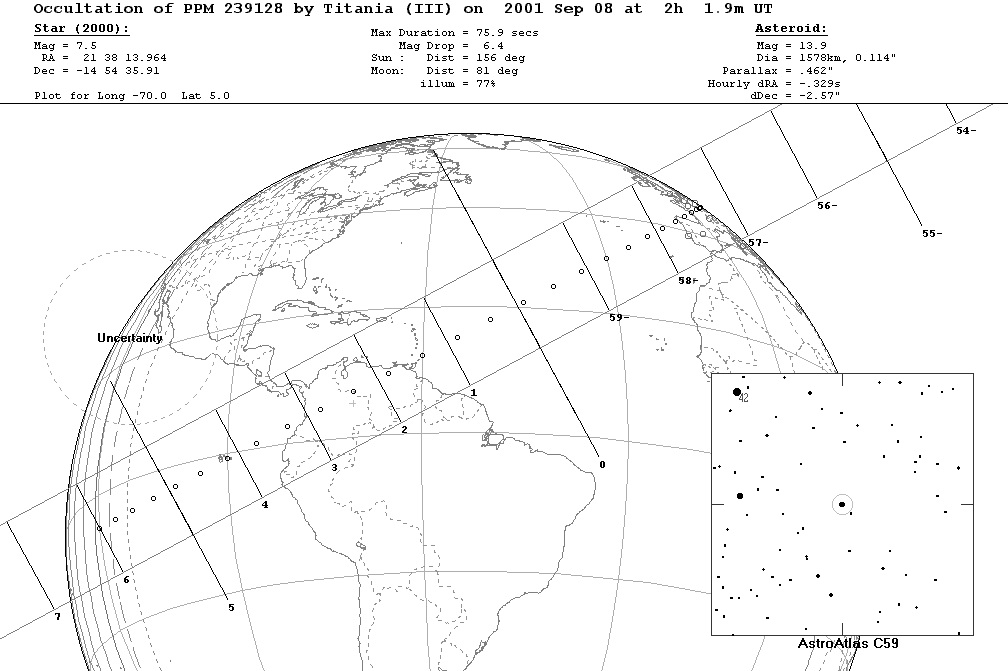
Here is further information on the star: Aliases: HD 205829 BD-15 6027 GC 30276 GSC 05799-01022 HIC 106829 HIP 106829 IRAS 21354-1508 PMC 90-93 6284 PPM 239128 SAO 164538 SKY# 41252 SRS 16903 TYC 5799 1022 1 uvby98 100205829 YZ 105 8137 ZC 3167 ICRS 2000.0 coordinates 21 38 13.9595 -14 54 35.958 [11.30 6.30 94] FK5 2000.0/2000.0 coordinates 21 38 13.96 -14 54 36.0 [11.30 6.30 94] FK4 1950.0/1950.0 coordinates 21 35 29.60 -15 08 10.6 [65.39 36.80 92] Galactic coordinates: 38.01 -43.58 Proper motion (mas/yr) [error ellipse] 26.77 29.50 [ 1.27 .72 93] B magn, V magn, Peculiarities 8.24, 7.20 Spectral type: K0III Parallaxes (mas) 5.89 [.91]
The lightcurves below show computed occultation signatures of static Titania atmospheres of pure nitrogen with surface pressures of 0.1 (blue) and 1 microbar (black). The atmospheres are assumed to be at a constant temperature of 60 K. The 1-microbar atmosphere would be easily detected. The 0.1-microbar atmosphere could be detected with good photometry (at a level of about +/- 3% for 1-sec integrations). This could be achieved with a large aperture or by combining a large number of independent observations. Both approaches are desirable. If the atmosphere is in a state of blow-off, like a cometary atmosphere, the atmospheric density might vary proportional to 1/r^2, much more slowly than an exponential static atmosphere. The occultation signature of this case would be a much more gradual decline in flux, as shown in green in the figure below. To be detectable, the base density of such an atmosphere would have to be at least equal to the density of a 1-microbar atmosphere at 60 K. All this assumes an occulted star with a radius about 15 times the Sun's, with a distance for the given parallax of 170 pc. We now estimate a projected stellar diameter at Uranus equal to about 11 km, or 0.54 s in time.
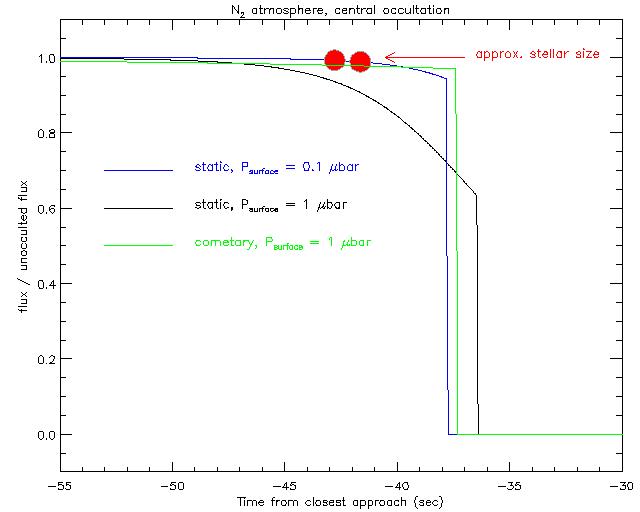
Dear Titanians, You will find linked to this page three JPEG files showing synthetic light curves for the Titania occultation, for three hypothetical pressures at the surface: 15, 1 and 0.1 mubar. All the curves assume N2 atmosphere with scale height H= 47 km (corresponding to T= 60K). Each figure is supposed to have 4 panels (will be fixed later). The pressure printed in the lower left corner is the pressure at the surface. The quantity "b" is the impact parameter, i.e. the distance of closest approach of the observer to the center of Titania's shadow.
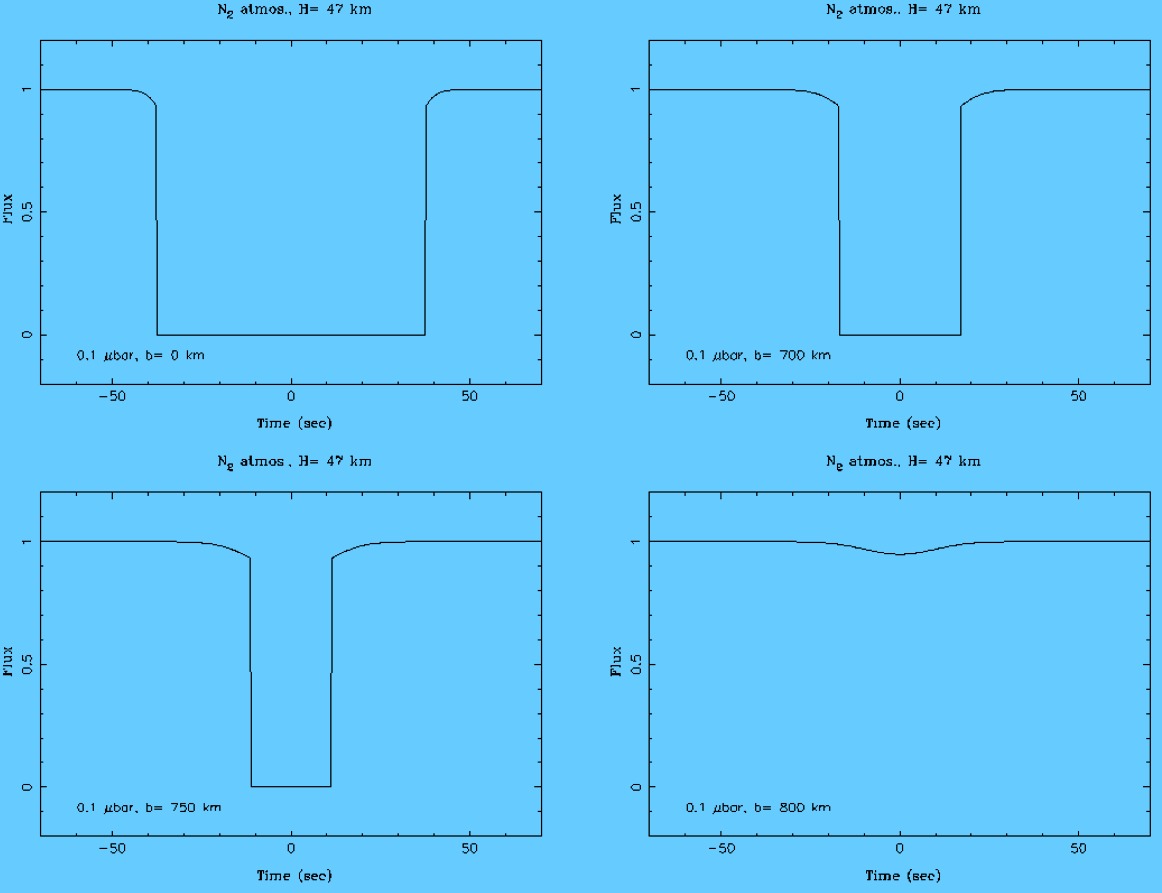
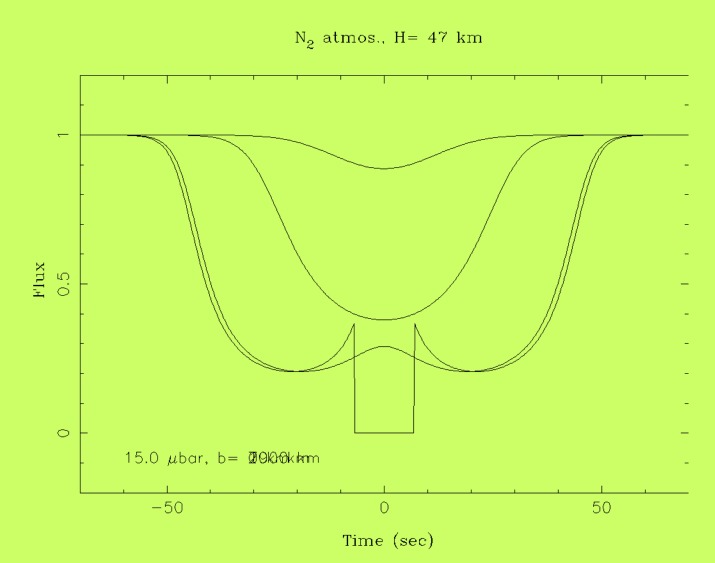
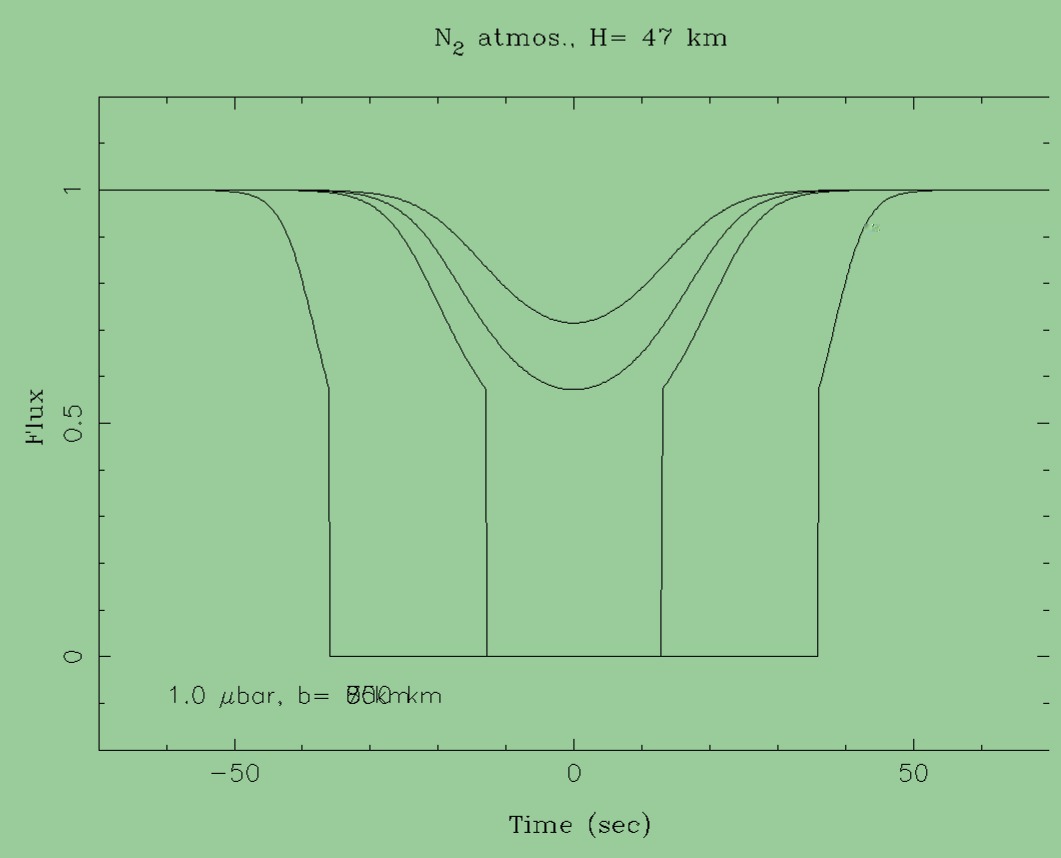
From Bruno.Sicardy@obspm.fr Thu Jul 12 09:27:46 2001 July 12, 2001 Dear all, I have looked at Bill Owen's astrometric measurements. Bill gives positions of Uranus, Umbriel, Titania and Oberon on May 17, June 20 and June 21, 2001, using images obtained at Table Mountain. I have calculated the 0-C's wrt the JPL on line ephemeris "Horizon", which is supposed to be linked to the same system (ICRS) as Bill's measurements, if I understood well. I assume that the 0-C's are the same for all these bodies, i.e. that we are dealing with a systematic error of ALL the Uranian system. In other words, I assume that the theory of Uranian satellites is correct. I discussed that in previous messages. Errors in the predicted satellites positions wrt to Uranus should be about 150 km, while errors on the position of the all system in space could be approx. one order of magnitude larger. For the moment, I have used ONLY 0-C's derived from Titania (8 positions) and Oberon (8 positions). Out of the 6 positions for Umbriel, 3 (those of May 17) appear quite deviant. I may discuss that directly with Bill. Also, I have NOT used the O-C's of Uranus (3 positions), as I doubt that 0.1 arcsec accuracy is available on an extended disk (almost 4 arcsec in diameter) In any case, including the Uranus and Umbriel data points would not change the basic conclusions given below. From the 16 Titania and Oberon positions I derive the following 0-C for the Uranian system: (0-C) alpha*cos(delta)= -0.051 arcsec +/- 0.083 s.e. (0-C) delta = -0.067 arcsec +/- 0.071 s.e. and I use the following ICRS position for the star: alpha= 21 h 38 mn 13.96284 sec delta= -14 d 54 ' 35.9070 " (as discussed previously) As a consequence, the closest approach star-Titania for a geocentric observer occurs at 01 h 59 mn 50 sec UT Sept. 8, with typical error of 1 mn. The impact parameter is such that the star passes 0.194 arcsec north of Titania at C/A, again for a geocentric observer. This is close to the diagram prepared by Dave Herald in February 2001, with a slight shift of the shadow to the south. Practically, this means for instance that Quito (Ecuador) is practically on the centrality. Still, the variance of the measurements is still of the order of 1000 km (~ 0.08 arcsec), while the shadow has a total width of 1600 km, but we start to have a good idea of what is going on. I attach a .ps file showing the shadow path onto the Earth, using the 0-C quoted above. Two sites (Quito, Ecuador, and Tenerife, Canary Islands) are plotted for information. The bullets on the centrality are plotted every mn, from 01h 53 mn UT (upper right) to 02h 05 mn UT (lower left). The meridians are plotted avery 30 deg (2 h), with the origin (Greenwich x equator) labelled by (O deg, 0deg). (Talking about that, I would like to have a software or some data file containing coastal lines in order to be able to plot the Earth continents at a certain time as seen from a certain direction. Can someone help me?). More to come as new measurements are made... Cheers, Bruno

To get a postscript version (higher resolution) of this plot go HERE.
Enclosed are old Titania/Oberon data as well as more recent observations. All the positions are determined differentially with a large format CCD and use ACT/Tycho-2 reference stars in the reductions. Accuracies are very similar to that obtained at Table Mt Observatory by Bill Owens. --Ron USNO Flagstaff Station
From Bruno.Sicardy@obspm.fr Fri Jul 20 10:45:50 2001 Thanks to Dave Dunham, I now have a big file containing the coasts and borders of the world, so that I could print the maps of the countries together with Titania's shadow track. The astrometry is as described in my previous mail (July 12). I attach 3 postscript files, a general one, + two more detailed views of Europe and S. America, respectively.

To get a postscript version (higher resolution) of this plot go HERE.

To get a postscript version (higher resolution) of this plot go HERE.
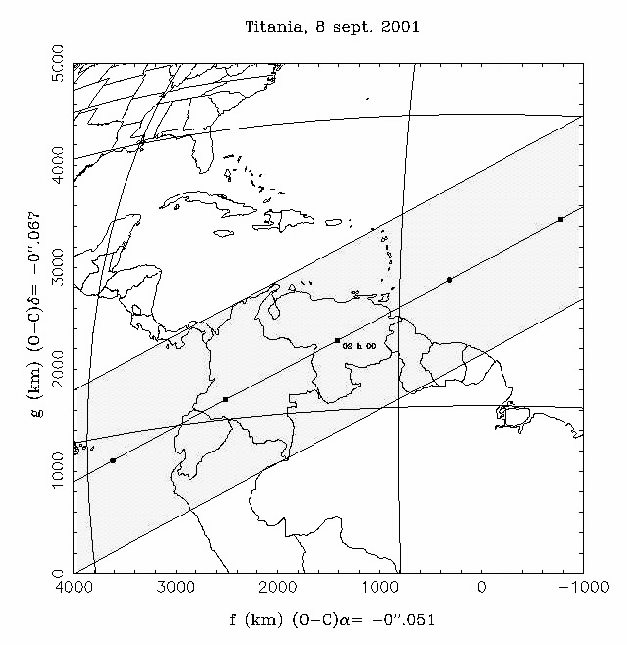
To get a postscript version (higher resolution) of this plot go HERE.
From Bruno.... Some remarks about the observations in Venezuela: ->The most important is to get a lightcurve of the event with sufficient time resolution. Titania is going 20 km/sec with respect to the star, projected onto the the plane of the sky. Thus we need 1sec resolution or better in order to resolve an atmosphere, which is likely to have a scale height of no more than 30-40 km. ->Fast CCD images or video, or any fast imager with reasonable linearity are ok. A fast aperture photometer could be tricky becaus Uranus will be close and bright (V= 5.7 at 16 arcsec from the star, V= 7.1). Scattered light from the planet would contaminate the aperture, and make the interpretation of the lightcurve difficult after the event. The best would be at have some IOTA cameras in Venezuela, or some good video camera whose signal could be digitized afterward. ->It is important to record the all event, not just the ingress and egress. If the atmosphere is thick enough, the occultation will be rather smooth and the star may not disappear completely even when it is the geometrically behind Titania. ->It is important to note that there is still an uncertainty which corresponds to about one radius or more of Titania. In other words, the gray stripe on the diagrams (track of the shadow on the Earth) may still shift north or south by half its width or even more. So, it would be wise to observe even if you are outside the nominal track. ->I do not think that spectra will be very useful, since the atmos. will be so tenuous that absorption lines will be impossible to detect. ->We do NOT know if Titania has an atmosphere. This is a prospective experiment. The problem is the star scintillation in the Earth atmos, NOT the photon noise, since the star is so bright. Thus, a big telescope like the 1-m is good not because it collects more photons, but because it reduces the scintillation wrt a 20cm telescope. Under good conditions, we can detect down to 10^{-7} bars at the surface of the satellite. ->To make tests, you can use a double star which simulates nicely Uranus + the star at the moment of the occultation: SAO 10937 (HIP 207 and 208 in Cassiopea, RA: 00h 02m 36.087 sec DE: +66d 05' 56.28" (J2000) with separation 15.2 arsec, V= 5.9, type G8 III, V= 7.2, type A2 V, for each star respectively. It could be useful for tests of saturation, scattered light, scale, etc... Note however that the occulted star is red, while the fainter star in the binary above is blue, so tests could be misleading outside the V band. Cheers Bruno Sicardy Observatoire de Paris 92195 Meudon Cedex Principal France <+><+><+><+><+><+><+><+><+><+><+><+><+><+><+><+><+><+><+><+><+><+><+> Dear Titanians, I received last week astrometric results from Bordeaux, giving some O-C's for the Uranian system. Michel Rapaport obtained 11 positions for Uranus, 7 for Titania and 7 for Oberon, wrt Hipparcos stars, with the meridian instrument. The average O-C obtained from Titania and Oberon positions is: O-C alpha*cos(delta)= -0.065" O-C delta = -0.057" which yields the track shown in the attached ps file. This new prediction is north of, but otherwise essentially the same as the one previously derived from Bill Owen's observations at Table Mountain, and from which I derived the tracks posted on Rik Hill's site on July 20 (see http://www.lpl.arizona.edu/~rhill/planocc/titania/titania.html) I did not include the O-C of Uranus in the present track, since the planet is 3.8" across, and thus with a more poorly defined photocenter than the satellite. In any case the O-C of Uranus would not change much the present track. There is still a problem of error bars: the Bordeaux observations have typical dispersions of < ~ 50 mas, i.e. about one Titania radius. Thus, the track shown in the attached ps file can still be off by +/- one Titania radius, i.e. one Titania diameter full width. In other words, all the observations (Ron Stone, Bill Owen, Michel Rapaport) are pretty consistent, but none of them really pin down the error bars below +/- one Titania radius. Averaging all these results is tricky because some systematic errors could linger in each of these observations. What would be needed now is having Titania and the star on the same plate and make direct differential astrometry. The two bodies are about 1 deg apart now. Can anybody do that ???????????? Cheers Bruno